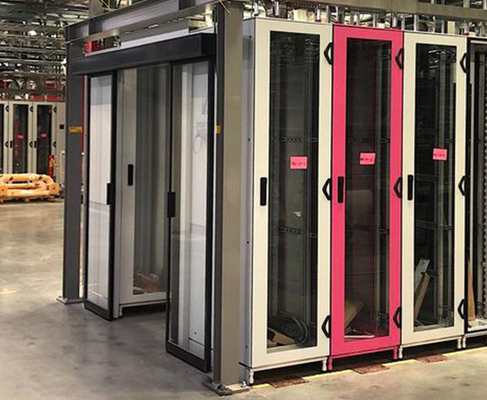Summary:
Location: Lund, Sweden
Situation: The multi-disciplinary research facility European Spallation Source (ESS), based on the world’s most powerful linear proton accelerator, sought a state-of-the-art containment and cooling system solution to protect the accelerator’s control system.
Solution: Cabinet solutions for the electrical/electronic equipment to control the accelerator
Results: The comprehensive solution met all specification and requirements for containment, and was completed on time and within budget.
SITUATION
The European Spallation Source (ESS) set out to build a world-leading multidisciplinary research facility. Once fully operational, the facility, based on the world’s brightest neutron source, which is an extremely advanced and complex machine, will enable scientific breakthroughs in research related to materials, energy, health and the environment.
The facility design includes the most powerful linear proton accelerator ever built, where the spallation process to generate neutrons for research begins. The ESS accelerator high-level requirements are to provide a 2.86 ms long proton pulse at 2 GeV at repetition rate of 14 Hz. This represents 5 MW of average beam power with a 4% duty cycle on target. ESS features a Helium-cooled tungsten target wheel, 15 state-of-the-art neutron instruments, a suite of high technology laboratories, and super-computing data management and software. Intricate control systems monitor and manage tens of thousands of devices, and integrate the operations of all facility infrastructures through a network of hardware, software and configuration databases.
For this incredible feat of science and engineering, the research facility sought a state-of-the-art containment and cooling system solution to connect and protect the complex electrical and electronic equipment to control the accelerator. The nVent SCHROFF team eagerly stepped forward and answered the highly competitive call in 2017 for tenders.
“For many of us, this ambitious project is a once-in-a-lifetime opportunity,” said Ulf Broome, regional account manager for nVent SCHROFF. “Plus, we were confident from experience on other crucial physics and larger research centres that our extensive team and resources could deliver the ESS’ design, installation and delivery needs. We were thrilled when we learned we were awarded the contract!”
SOLUTION
As part of the tender process, ESS provided the nVent SCHROFF engineering team with specifications for 19” racks, cooling and power distribution units (PDUs) used in the 500-meter-long gallery building. The gallery was to feature 20 hot aisle cabinet solutions, including 900 19” racks, 200 in-row coolers and about 900 PDUs. The equipment needed to be hosted and efficiently kept cool – preventing temperature fluctuations in electronics cabinets is a basic requirement for highly complex physical applications. As an additional challenge, the heat dissipation varied depending on the assembled modules, with some specified areas requiring especially tight temperature ranges. (Image 1)
Based on the specifications, the SCHROFF engineering team calculated the cooling performance based on the ESS provided heat load for every single containment or rack row and they also factored for worst-case scenarios. As they arrived at state-of-the-art design strategies, they conducted detailed validation of the proposed solution, including its ability to manage cooling, through simulation testing. (Image 2)
The application relies on hot aisle containment configurations of racks that contain the electronic and electrical equipment. In-row coolers are placed to maintain consistent air flow in front of each rack, and redundancies are provided for the in-row coolers. The application also allows for fan speed variations to adopt to varying heat loads in the different sectors and provide options for energy savings. All the specified products came from the extensive nVent SCHROFF portfolio of standard products that are specially designed to enable engineers to configure unique, highly available and cost-effective systems.
Armed with a comprehensive solution that met all the stated tender requirements, nVent SCHROFF provided drawings with proposed products specified and simulations to ESS for approval.
In the process, the original specifications from the tender changed several times as the design details of the various accelerator systems evolved during the multiyear construction. With each shift, the agile nVent SCHROFF team listened attentively to the new direction, adopted product configurations accordingly, and conducted new calculations and simulations to adapt and deliver the modified solution.
The final solution comprises symmetrical configurations of racks for each row, with coolers and redundancies to maintain homogeneous air flow. It also allows for fan speed variations to accommodate heat loads in the different sectors and provide options for energy savings. (Image 3)
RESULTS
Now the final solution comprises 20 hot aisle containments including over 900 19” Schroff Varistar racks, around 200 Varistar SHX cooling units and close to 900 hundred of power distribution units (PDUs). The SCHROFF team completed each of its designated responsibilities – from design through delivery, installation and commissioning – on agreed schedule and budget.
“It is a multifaceted, living project and we were happy to be flexible and agile in our support, especially as tweaks were made to honour the needs of the scientific community,” said nVent, Carsten Müller, Lead Project Engineer “We are pleased to deliver quality, design and installation to ESS, and with the functionality of the solution. We are extremely happy to take part in this scientific project.”
Looking ahead, the SCHROFF team is ready to continue to support ESS in various areas.
Image 1:

Image 2:

Image 3:

Media Contact at nVent:
Jasmin Goelzenleuchter
Marketing Manager
nVent
+31 638 324 143
Jasmin.Goelzenleuchter


